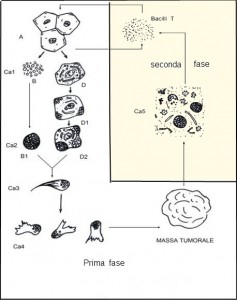Se la cellula cancerosa almeno al suo esordio “non procura nessun fastidio”, perché essa ad un certo punto conduce alla morte un organismo per altri versi sano?
La spiegazione va ricercata nella dinamica del processo canceroso che non é spiegato solo dalla formazione e dalla presenza della cellula cancerosa.
Esso e’ composto almeno da due fasi ben distinte e contrapposte.
Nella prima fase si possono far rientrare tutti gli stadi fino ad ora descritti:
– reazione vescicolare delle cellule.
– aggregazione delle vescicole.
– trasformazione degli aggregati in cellule cancerose.
– maturazione ed evoluzione delle cellule cancerose.
– formazione della massa tumorale.
Arrivati fin qui il cancro non è ancora un vero problema, lo dimostra il fatto che molti pazienti convivono con esso anche per anni senza accorgersi di essere malati.
Se i malati di cancro non si accorgono subito della malattia molto probabilmente il problema non risiede in questa prima fase.
La gravità di tutti i tumori solidi in effetti non risiede nella cellula cancerosa viva bensì in quella morta.
Il processo canceroso in realtà è composto da una seconda fase, inversa alla precedente.
Spieghiamoci meglio.
Le cellule tumorali sono a tutti gli effetti organismi viventi e come tali hanno un ciclo di vita ovvero una nascita ed una morte.
Cosa succede durante il processo canceroso?
Quando si forma la massa tumorale, al suo interno essa é composta da cellule molto vecchie che dopo aver concluso il proprio ciclo vitale muoiono da sole di vecchiaia.
Esse vanno in putrefazione all’interno dell’organismo con una putrefazione simile alla putrefazione post-morte.
Ciò innesca un particolare e ben preciso fenomeno.
La massa tumorale in putrefazione produce una serie di “detriti” e batteri della putrefazione alcuni dei quali hanno una particolarissima funzione: stimolare la reazione vescicolare delle cellule ancora sane.
In questo modo si chiude il cerchio.
– Le cellule ancora “sane” vengono stimolate a produrre nuove vescicole che riaggregandosi producono la nuova generazione di cellule cancerose che si sommano alle precedenti.
– Anche queste nuove cellule cancerose, terminato il loro ciclo vitale, muoiono a loro volta.
– La loro morte produce ancora una nuova ondata di putrefazione dei tessuti che si aggiunge alle precedenti ed il cerchio si chiude di nuovo.
Quindi nell’organismo si generano ciclicamente ondate sempre più grandi e frequenti di questi particolari “detriti” creando un meccanismo perverso che si autoalimenta ad ondate successive sempre più forti e massicce fino alla morte dell’organismo.
Il processo canceroso nei suoi aspetti salienti é tutto qui.
Nella schema che segue è rappresentato un disegno riepilogativo di tutto il processo.
A = Cellule sane
Ca1(B) Ca2(B1) = Evoluzione delle vescicole che si aggregano all’esterno delle cellule.
Ca1(D-D1-D2) = Maturazione delle vescicoleall’interno delle cellule.
Ca3= Cellula claviforme.
Ca4= Cellule mobili.
Massa Tumorale in decomposizione
Quadro microscopico del sangue Ca5
Produzione di batteri della putrefazione e “detriti”.
Riepilogo delle fasi del processo canceroso
La prima fase é caratterizzata dalla:
1-Reazione vescicolare delle cellule sane, prodotta e stimolata dalla presenza dei bacilli T.
2-Aggregazione vescicolare, formazione e maturazione delle cellule cancerose.
3-Formazione della massa tumorale.
La seconda fase è invece caratterizzata dalla:
4-Morte e decomposizione putrida delle cellule cancerose che compongono la massa tumorale.
5-Massiccia, progressiva ed accelerata intossicazione del sangue da parte dei “detriti”, dei batteri della putrefazione e bacilli T.
6-Cachessia, putrefazione generalizzata di tutto l’organismo e conseguente morte.
In un organismo sano, le cellule muoiono ugualmente ma a differenza di un organismo bioenergeticamente debole, esse sono “riassorbite” dall’organismo proprio come in un’economia sana e florida il personale licenziato da una azienda viene riassorbito e assunto in un’altra.
segue: I BACILLI T (descrizione generica)
–
per contatti telefonici:
Dr. Armando Vecchietti
335 5684474
%
